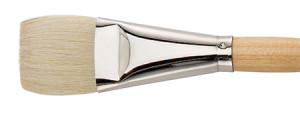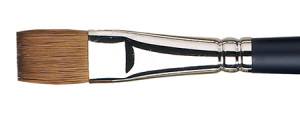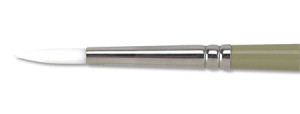Types of Bristles for Oil Painting Brushes
If yous're an oil painting artist, it is important to know the unlike types of bristles for oil painting brushes. Having cognition of bristle types will aid you cull the right castor. The term "bristle" refers to the hairs that make upwardly the brush caput of a paintbrush. The brush head is the part of an creative person'due south brush that holds and delivers paint to the canvas's surface.
Beard for oil painting brushes are made from two types of pilus, natural hair, and constructed hair.
Natural Hair
Bristle and sable are the 2 master types of hair used in natural brushes. Artists prefer natural bristles for oil paints because they are softer than synthetic bristles.

Bristle brushes are stiff and springy brushes made of the hairs from the back of a hog. They have natural "split-ends," which make them ideal for oil painting because they tin withstand heavy oil paint, textured canvas, and harsh solvents like turpentine. The strong bristles will leave a strong marker on the sheet. In add-on, Bristle brushes are piece of cake to clean.
Bristle brushes are all-time in sizes of a one-half-inch wide or larger. They are all-time when used in large areas of a canvas, to begin a painting, or for very large paintings. Unabridged paintings may exist painted using merely bristle brushes. However, you would want to switch to sable brushes if you wish to have effectively detail in smaller areas.

Sable brushes practice not come from sables. Instead, they are made from any fellow member of the weasel family unit with "cerise" hair.
Sable brushes are softer and more than delicate than a bristle or constructed brushes. They are as well more expensive and crave more intendance.
Sables are cracking for blending, glazing, and making soft, less-defined marks. In addition, they are groovy detail brushes. The best sizes for this brush are a one-half inch in width or smaller. Artists painting with oils often prefer their long handles, which allows them to work at a greater distance from their painting.
Some less mutual natural hairs used for painting brushes are badger, camel, goat, mongoose, ox, pony, and squirrel.
Constructed Hair

Synthetic brushes are manufactured from either nylon or "Taklon," a polyester filament. This paintbrush offers more versatility than natural because it may exist used with acrylic and oil paints. These brushes are a practiced budget alternative to natural bristle brushes, simply brand sure they're made for oil paints.
Some advantages of constructed brushes are:
-
- They are more resistant to damage from turpentine, insects, or paints.
- Cleanup is easier since they don't tend to trap paint in the individual hairs.
- The hairs last longer because they are less prone to suspension and are more durable on many different canvas surfaces.
Ane disadvantage is the less expensive synthetic brushes tend to lose their shape more speedily than natural hair brushes.
Additional Reading
All Yous've E'er Wanted to Know About Artist Brushes and And then Some — Part one
Beefcake of The Artist Paint Brush
Types of Artist Brushes for Oil Painting
Take a question?
If you have a question about this painting, please contact the states, and we'll exist happy to answer any of your questions.
Cheers for reading this!
Feel free to share this with your friends.
Enjoy this page? Delight share it. Thanks!
Source: http://teresabernardart.com/types-of-bristles-for-oil-painting-brushes/
Enregistrer un commentaire for "Types of Bristles for Oil Painting Brushes"